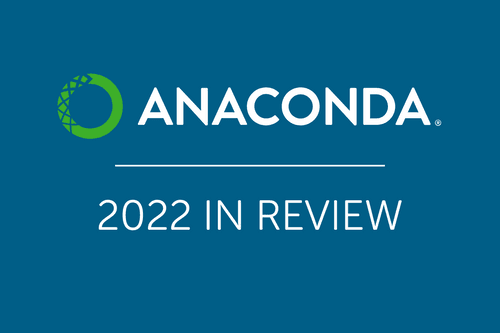2022: An Anaconda Year in Review


Today more than ever before, businesses around the world are embracing data and data-driven decisions as key aspects of operating a modern, successful organization. Yet, despite the surface-level recognition of the importance of data and the insights it can provide, the process of harnessing data and mining those insights is often perceived as abstract and mysterious—a domain that solely belongs to experts with PhDs.
While it’s true that extensive training in cleaning data, adjusting models, and interpreting insights is necessary to be a successful data scientist, the notion that other operators in a business do not need to know anything about the world of data is detrimental. Making sense of data and making decisions based on it cannot happen in an ivory tower; if business leaders can’t ask informed questions about the origins of data and tradeoffs made in model selection, then they’re unlikely to ever achieve the full value of their data science programs. Instead, data practitioners and non-technical business leaders must meet in the middle.
We’ve previously discussed how data scientists can better uplevel and explain their work so that it’s accessible to a less technical audience; in this blog post, we’ll talk about how business executives can increase their data literacy to be better partners to the data organization. By raising the bar for data literacy among all employees, companies will find themselves better equipped for the future of work and empowered to realize the full value of a data-driven culture.
Starting with the building blocks
Similar to how computer literacy has become a must-have in today’s society, the next foundational skill for professionals will be data literacy. From marketing to recruiting to product development, every function is becoming more data-driven. And in the future, this trend will evolve such that every job requires a base familiarity with data. The best way to prepare for this trend is to upskill your workforce today.
This starts with an education around the fundamental principles of data, and what data science can and cannot do. While business tools such as Excel and Google Sheets have made data modeling more accessible, we cannot equate this to data analysis. Spreadsheet thinking is insufficient for capturing the full nuances of data, such as concepts of probabilities and inferences. Broad data literacy will start with basic building blocks of how to approach data. Whether this starts with creating a training program led by in-house data experts, bringing in an outside consultancy, or leveraging online courses, there are a variety of ways to invest in the professional development of your workforce.
Cultivating the data intuition
Working with data is more than writing code or tuning models—it requires a sharp intuition to contextualize and comprehend the information at hand. This ability is something that can be trained by developing critical thinking to ask the right questions. While not everyone needs to become a data expert, helping employees understand the context in which data science insights are provided and the limitations of certain models will help businesses take the best possible action in response to data findings.
The goal of broader data literacy is not to expand the data science team; rather, it’s to empower a wide array of employees to develop keen judgment and feel confident in decision-making when provided with data. Building this muscle requires practice: getting comfortable looking at datasets, figuring out what they are telling you, and understanding the potential explanations hidden inside the relationships. As champions of data, today’s data scientists have a responsibility to familiarize their colleagues with statistical reasoning and the scientific process.
Meeting in the middle with data experts
In conversations with both business leaders and data science practitioners, we sometimes observe a mismatch in communication between each side about how data can best help the business. Business leaders expect data scientists to generate a clear-cut recommendation on where to steer the company, while data scientists seek room for exploration to test out hypotheses about what their data shows. To bridge the gap, both sides have a responsibility to understand and speak the other’s “lingo.” For business leaders, a foundational data literacy will ensure they’re better equipped to work with their data scientists. Similar to how we can’t all be expected to write like professional authors, but are expected to read and write to communicate with others, data literacy will be foundational in improving collaboration with the data science function.
When reviewing the results from a given model, decision-makers should be able to ask questions like: “How did we select the data for this model?”, “How heavily do different parameters influence the model’s output?”, “How strong are the confidence intervals?”, and “How can we test for bias?” A thorough understanding of data begins with accepting the fluidity of data—recognizing that the straight line graph that we so often desire is usually an oversimplification. Working with real data may produce shaded regions or error bounds that may not paint a perfectly clear picture, but are nevertheless highly valuable in guiding leaders toward a decision.
Companies today have access to more data than ever before. While having a strong data science team is a key component in maximizing the value of that data, it’s not the whole story. Non-technical employees must also increase their data literacy to better understand and work with model results. Just as the most successful data experts learn how to communicate their work to non-technical audiences, so too do the best business leaders learn how to be more informed partners to their data teams. Broader data literacy will become a hallmark of future data-driven organizations, and companies that invest in upskilling their workforces today will be set up for long-term success in their data science strategies.
Talk to one of our experts to find solutions for your AI journey.